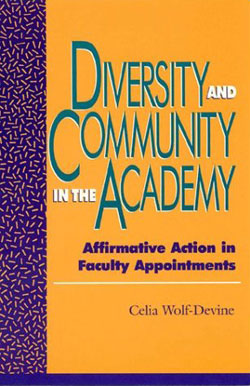Diversity and Community in the Academy:
Affirmative Action in Faculty Appointments
 (from the back)
(from the back)
In the wake of court rulings that have forced university administrators to reevaluate affirmative action policies, this balanced, thoughtful book examines three typical defenses of these policies: that affirmative action compensates for past discrimination; that it provides role models and ensures diversity; and that it corrects for systemic bias against women and racial minorities. While Wolf-Devine finds that none of these arguments justifies adopting affirmative action, she diverges from most opponents of the policy by arguing that some circumstances make affirmative action appropriate. Analyzing the cultural, economic, and political contexts in which affirmative action has been debated, she suggests ways to get around the current impasse over the issue without abandoning a commitment to social justice. The depth and balance of the book are enhanced by an appendix containing articles by noted legal expert George Rutherglen, distinguished philosopher James Rachels, and independent scholar Richard Rodriguez.
Table of Contents
Introduction
Chapter 1: Historical Introduction
I. From Civil Rights to Affirmative Action: 1964-1972
Background
Laying the Foundations for Affirmative Action
Underlying Causes of the Trend Toward Proportional Representation
Adding Women: Linking Race and Sex
II. The Entrenchment of Bureaucracies: 1973-1980
Background
The Regulatory Agencies and the Universities
Affirmative Action in the Courts: Baake and Weber
III. The Reagan-Bush Years: 1980-1992
Economic Context
Changes in Political Culture: The PC Wars
The Courts
The Changing Demographics of the Academy
IV. Where We Are Now
Economic Context
Cultural Conflict
The Crisis in Education
Affirmative Action and the Crisis in Education
Chapter 2: Compensatory Arguments
I. The Argument
II. Evaluation
III. Application to Other Groups
Native Americans
Hispanics and Asians
Women
IV. Conclusion
V. Transition: A Cross-Temporal Argument
Chapter 3: Forward-Looking Arguments
I. Goods Internal to the University
Role Models
Mentors
Diversity
Internal Arguments: Summary
II. External Goods
Beyond Fantasy Politics
The Influence of Universities
The Redistributive Argument
Possible Bad Effects of Discontinuing Affirmative Action
III. Conclusion
Chapter 4: Corrective Arguments
I. The Postmodernist Argument
II. Bias Embedded Within the Traditional Disciplines
Establishing the Existence of Bias
Failure of the Androcentric Bias Argument to Justify Affirmative Action
III. Argument Based on Underrepresentation
IV Identifying Bias in Recent Appointment Patterns
V. Conclusion
Chapter 5: Conclusion
I. Remedies
II. Getting Around the Impasse
The Politics of Displacement
Defects in the Prevailing Social Paradigm
The Shape of the New Paradigm
III. The Role of the University
Developing a New Social Paradigm
The Advancement of Knowledge
Handing On Our Cultural Tradition
Imparting Basic Skills
Teaching the Art of Rational Dialogue
Tutoring
IV. The Problem Redefined
Supplementary Essays
Affirmative Action in Faculty Appointments: A Guide for the Perplexed by George Rutherglen
Are Quotas Sometimes Justified? By James Rachels
“Minority Student” by Richard Rodriguez.
[
top]
 (from the back)
(from the back)